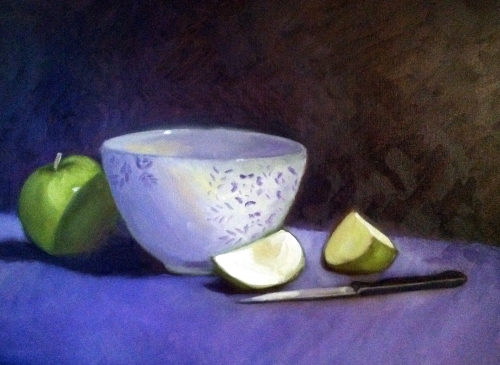Still Life - Class Two

Things to remember from class today:
Recipe for creating shadows for white - mix violet (a cool red (such as Alizarin Crimson) and a warm blue (Ultramarine blue)) plus white to get a gray.
The importance of hard, soft and lost edges.
When applying the final highlight, load your brush and apply liberally.
Taking a new class!

I'm taking a class by Sue Foell. She's a well known portrait artist, and I want to take her portrait class later, but started with her still life class.
Here's the main thing I learned in class today:
Recipe for Shadows:
The object's color + the compliment of that color + a darker version of the object's color
(The exception to this rule is white)
Complementary colors are those located opposite each other on the color wheel.
This was a good subject - it uses the primary colors. Notice how the red reflects off the vase, and even the wall. I didn't get the shape of the vase just right - am not happy with the shape of the pear either, but I feel like I got close to the actual colors of the still life.
Revisions to Welles Crowther

I think that it really helps when painting a portrait to actually know the subject. I've looked at several photographs of this brave young man and saw that I needed to make some big revisions to the painting. I'm not finished yet, but wanted to post how much the portrait is changing from the original concept.
The amazing thing has been the effect it has had on my son, who is 16. He had to write an essay at school about the qualities of a hero, and chose Welles Crowther as his subject. He wouldn't have even known about this young man if I hadn't been working on his portrait, so this has been a blessing to teach my son more about selflessness, caring about others, and the difference that one person can make on the lives of so many others.

